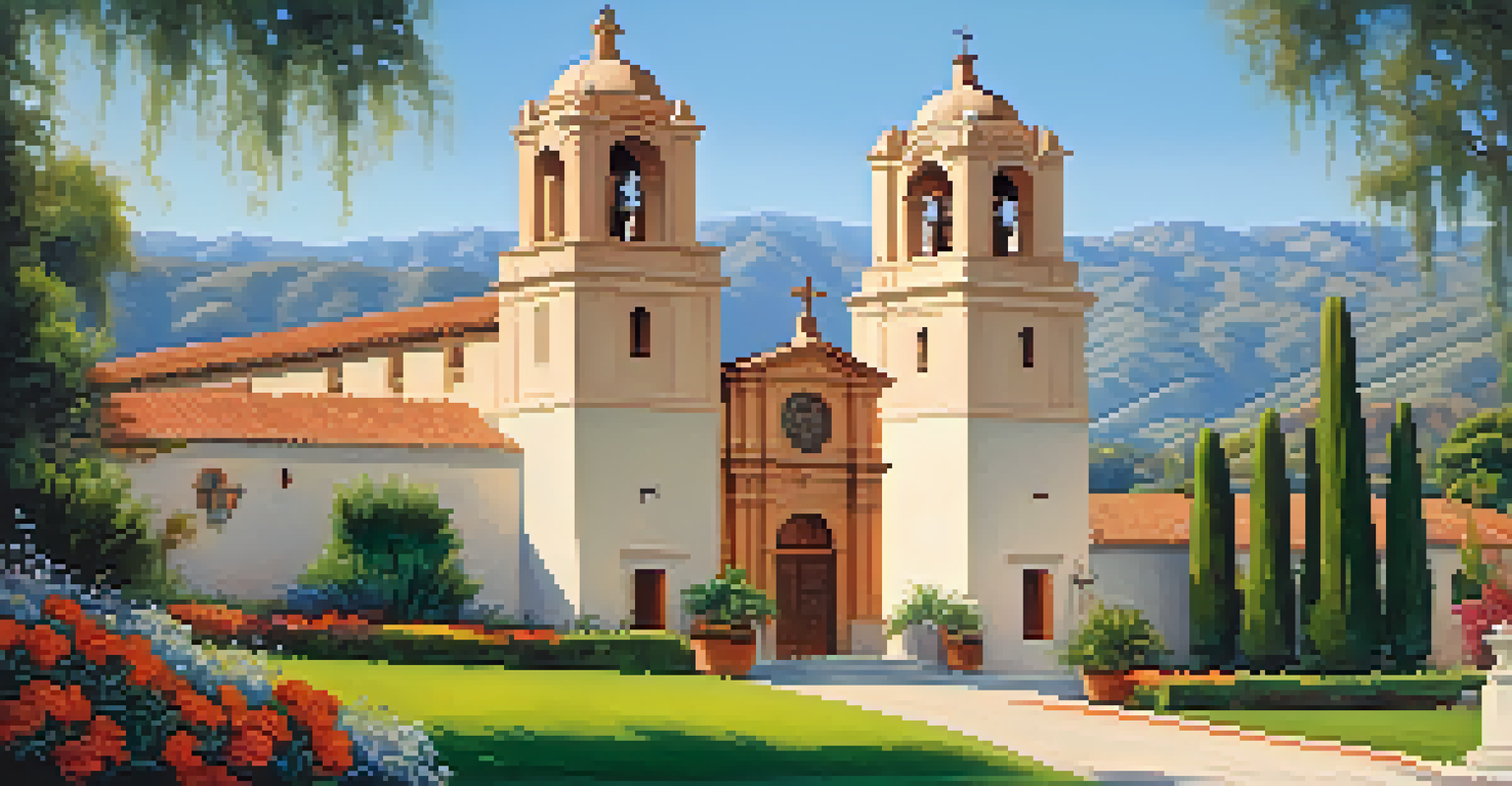Exploring the Historic Missions of California's Coastline

Introduction to California's Historic Missions
California's coastline is dotted with historic missions that tell the story of the state’s early days. Founded by Spanish settlers in the 18th and 19th centuries, these missions served as religious and cultural hubs. They played a crucial role in the spread of Christianity and the Spanish way of life in California.
History is not a burden on the memory but an illumination of the soul.
Each mission has its own unique history and architectural style, reflecting the diverse cultures that influenced them. From the adobe structures to the lush gardens, these missions are more than just historical sites; they are a testament to resilience and adaptation. Visiting them is like stepping back in time, offering a glimpse into the past.
As we embark on this journey along the California coastline, we’ll explore some of the most significant missions. By understanding their history, we can appreciate the cultural heritage that continues to shape California today.
Mission San Diego de Alcalá: The First Mission
Mission San Diego de Alcalá, established in 1769, was the first of the California missions. It served as a starting point for the Spanish mission system and laid the groundwork for future missions along the coast. The mission's beautiful bell tower and serene garden invite visitors to reflect on its storied past.

One notable aspect of the mission is its role in the development of agriculture in the region. The early missionaries introduced new farming techniques and crops, which helped sustain the local community. Today, the mission is a vibrant cultural site that celebrates its heritage through festivals and events.
California Missions: A Historical Journey
The missions along California's coastline serve as vital historical landmarks that reflect the state's diverse cultural heritage.
Visiting Mission San Diego de Alcalá offers a unique opportunity to connect with California's history. Whether you're exploring the museum or walking the peaceful grounds, you can feel the spirit of the past resonate in the air.
Mission San Juan Capistrano: A Cultural Gem
Mission San Juan Capistrano, founded in 1776, is perhaps the most famous of the California missions. Known for its stunning architecture, especially the iconic stone ruins of the Great Stone Church, it attracts visitors from around the world. The mission is often referred to as the 'Jewel of the Missions' due to its beauty and historical significance.
Preservation of one's own culture does not require contempt or disrespect for other cultures.
Aside from its architectural splendor, the mission is also renowned for its swallows, which return every year. This natural phenomenon has become a symbol of renewal and hope for many, contributing to the mission's charm. The annual Swallows Day Parade is a lively celebration that showcases local culture and community spirit.
Exploring Mission San Juan Capistrano is like wandering through a living museum. With its art, gardens, and rich history, it provides a deep dive into the mission's role in shaping California's identity.
Mission Santa Barbara: The Queen of the Missions
Mission Santa Barbara, established in 1786, is often referred to as the 'Queen of the Missions.' Its elegant design and stunning location make it a must-visit site along California's coastline. The mission features a beautiful facade adorned with twin bell towers, showcasing the Spanish Colonial Revival style.
Beyond its aesthetic appeal, Mission Santa Barbara is significant for its commitment to education and community welfare. The mission has a long history of serving the needs of its local community, offering various programs and services. This legacy continues today, making it not just a historical site but a center for cultural and spiritual growth.
Cultural Significance of Missions
Each mission plays a unique role in promoting community, education, and spirituality, showcasing the resilience of the human spirit.
Visiting Mission Santa Barbara allows you to appreciate the blend of beauty and purpose. The mission's gardens, museums, and vibrant history create an enriching experience for all who visit.
Mission San Francisco de Asís: A Historical Landmark
Also known as Mission Dolores, Mission San Francisco de Asís was founded in 1776 and is the oldest surviving structure in San Francisco. Its quaint chapel and historical significance draw visitors eager to learn about California's early days. The mission's location in the heart of the city makes it a unique blend of history and urban culture.
The mission has undergone several restorations over the years, preserving its original charm while adapting to the modern world. Its museum showcases artifacts and exhibits that tell the story of the mission's role in the community. This connection to the past makes it a vital part of San Francisco's heritage.
Walking through Mission Dolores is like uncovering layers of history. From its architecture to the stories of those who lived and worked there, it offers a fascinating glimpse into the lives of early Californians.
Mission San Luis Obispo de Tolosa: A Hidden Treasure
Mission San Luis Obispo de Tolosa, founded in 1772, is often considered one of the most charming missions in California. Nestled in the heart of San Luis Obispo, this mission features beautiful gardens and a peaceful atmosphere, making it a perfect spot for relaxation. Its picturesque setting invites visitors to take a leisurely stroll through its grounds.
The mission is known for its vibrant community events, including farmers' markets and cultural festivals that celebrate local heritage. These gatherings bring people together and foster a sense of belonging, showcasing the mission's enduring role in the community. The blend of history and contemporary culture creates a unique experience for visitors.
Engaging Experiences Await Visitors
Visiting these historic sites offers enriching experiences that deepen understanding of California's rich history and cultural identity.
Exploring Mission San Luis Obispo allows you to appreciate both its historical significance and its continued relevance. It serves as a reminder of the past while remaining an active part of the community today.
Mission Monterey: A Gateway to California's History
Mission Monterey, established in 1770, was the first mission built in Alta California. Its location near the coast made it a pivotal point for trade and communication. The mission's charming architecture and rich history make it a fascinating stop on the coastal mission trail.
Monterey's mission played a significant role in the early days of California, serving as a base for explorers and settlers. Today, it stands as a historical landmark, showcasing artifacts and exhibits that tell the story of its past. The mission's museum offers visitors a deeper understanding of the region's history and cultural significance.

A visit to Mission Monterey allows you to connect with the early days of California. The combination of history, architecture, and beautiful coastal scenery creates an unforgettable experience.
Conclusion: The Legacy of California's Missions
The missions along California's coastline are more than just tourist attractions; they are vital pieces of the state's history. Each mission tells a unique story of faith, culture, and community, reflecting the diverse influences that shaped California. They serve as reminders of the past while continuing to inspire future generations.
As you explore these historic sites, you not only learn about history but also about the resilience of the human spirit. The missions have adapted to changing times, becoming centers of education, culture, and spirituality. They invite visitors to engage with history and discover the stories that connect us all.
In conclusion, visiting California's missions is a journey through time. Whether you're a history buff or a casual traveler, these sites offer enriching experiences that deepen your understanding of California's rich heritage.